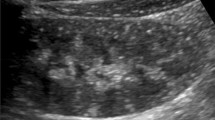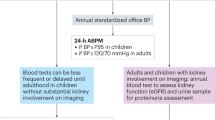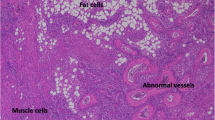Abstract
Background
Genes for tuberous sclerosis complex (TSC) type 2 and autosomal-dominant polycystic kidney disease (ADPKD) type 1 are both encoded over a short segment of chromosome 16. When deletions involve both genes, an entity known as the TSC2/ADPKD1 contiguous gene syndrome, variable phenotypes of TSC and ADPKD are exhibited. This syndrome has not been reviewed in the radiology literature. Unlike renal cysts in TSC, cystic disease in TSC2/ADPKD1 contiguous gene syndrome results in hypertension and renal failure. A radiologist might demonstrate polycystic kidney disease before the patient develops other stigmata of TSC. Conversely, in patients with known TSC, enlarged and polycystic kidneys should signal the possibility of the TSC2/ADPKD1 contiguous gene syndrome and not simply TSC. Distinguishing these diagnoses has implications in prognosis, treatment and genetic counseling.
Objective
To describe the clinical and imaging findings of tuberous sclerosis complex and polycystic kidney disease in seven pediatric patients.
Materials and methods
We retrospectively reviewed renal and brain imaging of children and young adults with genetically proven or high clinical suspicion for TSC2/ADPKD1 contiguous gene syndrome.
Results
We included seven pediatric patients from two referral institutions. Ages ranged from birth to 21 years over the course of imaging. The mean follow-up period was 9 years 8 months (4 years 6 months to 20 years 6 months). No child progressed to end-stage renal disease during this period. Three patients were initially imaged for stigmata of TSC, three for abdominal distension and one for elevated serum creatinine concentration. All patients developed enlarged, polycystic kidneys. The latest available imaging studies demonstrated that in 12 of the 14 kidneys 50% or more of the parenchyma was ultimately replaced by >15 cysts, resulting in significant cortical thinning. The largest cysts in each kidney ranged from 2.4 cm to 9.3 cm. Echogenic lesions were present in 13 of the 14 kidneys, in keeping with angiomyolipomas (ranging from 0.4 cm to 7.8 cm). Compared to the latest imaging studies, the initial studies only demonstrated 64% of kidneys to be borderline or enlarged; the majority had 10 or more cysts and 0–5 echogenic foci in each kidney, measuring 0.8 cm maximally, which were possible angiomyolipomas. Increased cortical echogenicity was observed in eight kidneys, and decreased corticomedullary differentiation was demonstrated in six kidneys. Cortical thinning varied with size and number of cysts.
Conclusion
The sonographic renal findings in TSC2/ADPKD1 contiguous gene syndrome progress over time and demonstrate a specific pattern of renal disease different from typical tuberous sclerosis complex. There are multiple cysts at presentation and there is progressive enlargement of the kidneys and of the renal cysts. Because clinical or imaging findings of TSC may not manifest in the young child, the radiologist can be the first to suggest a diagnosis of TSC2/ADPKD1 contiguous gene syndrome and recommend thorough skin examination and imaging in search of TSC findings. The radiologist should be able to suggest the diagnosis of TSC2/ADPKD1 contiguous gene syndrome in children with TSC who have large cysts occupying a large portion of an enlarged kidney. This should not be dismissed as renal cystic disease of TSC or as ADPKD because the diagnosis of TSC2/ADPKD1 contiguous gene syndrome has implications for patient management and prognosis.



Similar content being viewed by others
References
Bisceglia M, Galliani C, Carosi I et al (2008) Tuberous sclerosis complex with polycystic kidney disease of the adult type: the TSC2/ADPKD1 contiguous gene syndrome. Int J Surg Pathol 16:375–385
Hartman TR, Liu D, Zilfou JT et al (2009) The tuberous sclerosis proteins regulate formation of the primary cilium via a rapamycin-insensitive and polycystin 1-independent pathway. Hum Mol Genet 18:151–163
Martignoni G, Bonetti F, Pea M et al (2003) Renal pathology in tuberous sclerosis complex. Pathology 35:505–512
Brook-Carter PT, Peral B, Ward CJ et al (1994) Deletion of the TSC2 and PKD1 genes associated with severe infantile polycystic kidney disease — a contiguous gene syndrome. Nat Genet 8:328–332
Steinman TI (2012) Polycystic kidney disease: a 2011 update. Curr Opin Nephrol Hypertens 21:189–194
Budde K, Gaedeke J (2012) Tuberous sclerosis complex — associated angiomyolipomas: focus on mTOR inhibition. Am J Kidney Dis 59:276–283
Longa L, Scolari F, Brusco A et al (1993) A large TSC2 and PKD1 gene deletion is associated with renal and extrarenal signs of ADPKD. Nephrol Dial Transplant 12:1900–1907
Kacerovska D, Vrtel R, Michal M et al (2009) TSC2/PKD1 contiguous gene syndrome: a report of 2 cases with emphasis on dermatopathologic findings. Am J Dermatopathol 31:532–541
Han BK, Babcock DS (1985) Sonographic measurements and appearance of normal kidneys in children. AJR Am J Roentgenol 145:611–616
Avni FE, Hall M (2010) Renal cystic diseases in children: new concepts. Pediatr Radiol 40:939–946
Avni FE, Garel C, Cassart M et al (2012) Imaging and classification of congenital cystic renal diseases. AJR Am J Roentgenol 198:1004–1013
Sweeney WE, Avner ED (2011) Diagnosis and management of childhood polycystic kidney disease. Pediatr Nephrol 26:675–692
Ravine D, Gibson RN, Waler RG et al (1994) Evaluation of ultrasonographic diagnostic criteria for autosomal dominant polycystic kidney disease. Lancet 343:824–827
Pei Y, Obaji J, Dupuis A et al (2009) Unified criteria for ultrasonographic diagnosis of ADPKD. J Am Soc Nephrol 20:205–212
Dell KM (2011) The spectrum of polycystic kidney disease in children. Adv Chron Kidney Dis 18:339–347
Gabow PA, Kimberling WJ, Strain JD et al (1997) Utility of ultrasonography in the diagnosis of autosomal dominant polycystic kidney disease in children. J Am Soc Nephrol 8:105–110
Henske EP (2005) Tuberous sclerosis and the kidney: from mesenchyme to epithelium, and beyond. Pediatr Nephrol 20:854–857
Roach ES, Sparagana SP (2004) Diagnosis of tuberous sclerosis complex. J Child Neurol 19:644–649
Roach ES, Gomez MR, Northrup MD (1998) Tuberous sclerosis complex consensus conference: revised clinical diagnostic criteria. J Child Neurol 13:624–628
Bernstein J (1993) Renal cystic disease in TSC. Pediatr Nephrol 7:490–495
Chen YL, Luo CB, Hsu SW et al (2001) Tuberous sclerosis complex with an unruptured intracranial aneurysm: manifestations of contiguous gene syndrome. Interv Neuroradiol 7:337–341
Denne C, Gerstl EM, Mayer K et al (2011) Uncommon presentation of tuberous sclerosis in an infant. Arch Pediatr 18:660–664
Smulders YM, Eussen BHJ, Verhoef S et al (2003) Large deletion causing the TSC2-PKD1 contiguous gene syndrome without infantile polycystic disease. J Med Genet 40:e17
Weber MA, Risdon RA, Malone M et al (2005) Isolated unilateral tuberous sclerosis-associated renal cystic disease in a neonate. Fetal Pediatr Pathol 24:267–275
Fick GM, Duley IT, Johnson AM et al (1994) The spectrum of autosomal dominant polycystic kidney disease in children. J Am Soc Nephrol 3:1654–1660
Casper KA, Donnelly LF, Chen B et al (2002) Tuberous sclerosis complex: renal imaging findings. Radiology 225:451–456
Krueger DA, Northrup H (2013) Tuberous sclerosis complex surveillance and management: recommendations of the 2012 International Tuberous Sclerosis Complex Consensus Conference. Pediatr Neurol 49:255–265
Conflicts of interest
None
Author information
Authors and Affiliations
Corresponding author
Rights and permissions
About this article
Cite this article
Back, S.J., Andronikou, S., Kilborn, T. et al. Imaging features of tuberous sclerosis complex with autosomal-dominant polycystic kidney disease: a contiguous gene syndrome. Pediatr Radiol 45, 386–395 (2015). https://doi.org/10.1007/s00247-014-3147-1
Received:
Revised:
Accepted:
Published:
Issue Date:
DOI: https://doi.org/10.1007/s00247-014-3147-1




